
Kanchanaburi: A Journey Through History and Nature
Discover Kanchanaburi, Thailand: A blend of poignant history, stunning waterfalls, serene temples, and friendly locals. Perfect for history buffs, nature lovers, and cultural enthusiasts.
Nestled along the banks of the River Kwai, Kanchanaburi offers a unique blend of history, natural beauty, and cultural richness. This charming city is most famous for the Bridge over the River Kwai and the Death Railway, poignant reminders of World War II. The war museums and cemeteries tell the tales of those who suffered and sacrificed, making it a must-visit for history enthusiasts. Beyond its historical significance, Kanchanaburi is a gateway to stunning natural landscapes. The Erawan National Park, with its seven-tiered waterfall, is a paradise for nature lovers and hikers. The park’s crystal-clear pools are perfect for a refreshing swim. Another natural wonder is the Sai Yok National Park, known for its beautiful waterfalls and caves. Kanchanaburi also offers unique cultural experiences. Visit the serene temples, such as Wat Tham Sua, which offers panoramic views of the surrounding countryside. The floating markets and night bazaars present an opportunity to taste local delicacies and shop for souvenirs. The city’s laid-back atmosphere and friendly locals make it an ideal destination for a relaxing getaway.
Local tips in Kanchanaburi
- Best time to visit is between November and February when the weather is cooler and more pleasant.
- Wear comfortable shoes for exploring the national parks and historical sites.
- Try local delicacies at the night bazaar for an authentic culinary experience.
- Take a guided tour to fully appreciate the historical significance of the Death Railway and the Bridge over the River Kwai.
- Carry insect repellent if you plan to visit the national parks.
- Respect local customs and dress modestly, especially when visiting temples.
Neighbourhoods in Kanchanaburi
Kanchanaburi: A Journey Through History and Nature
Nestled along the banks of the River Kwai, Kanchanaburi offers a unique blend of history, natural beauty, and cultural richness. This charming city is most famous for the Bridge over the River Kwai and the Death Railway, poignant reminders of World War II. The war museums and cemeteries tell the tales of those who suffered and sacrificed, making it a must-visit for history enthusiasts. Beyond its historical significance, Kanchanaburi is a gateway to stunning natural landscapes. The Erawan National Park, with its seven-tiered waterfall, is a paradise for nature lovers and hikers. The park’s crystal-clear pools are perfect for a refreshing swim. Another natural wonder is the Sai Yok National Park, known for its beautiful waterfalls and caves. Kanchanaburi also offers unique cultural experiences. Visit the serene temples, such as Wat Tham Sua, which offers panoramic views of the surrounding countryside. The floating markets and night bazaars present an opportunity to taste local delicacies and shop for souvenirs. The city’s laid-back atmosphere and friendly locals make it an ideal destination for a relaxing getaway.
When is the best time to go to Kanchanaburi?
Iconic landmarks you can’t miss
Wat Tham Suea (Tiger Cave Temple)
Explore the spiritual and scenic wonders of Wat Tham Suea, a breathtaking Buddhist temple in Kanchanaburi, Thailand, offering stunning views and cultural insights.
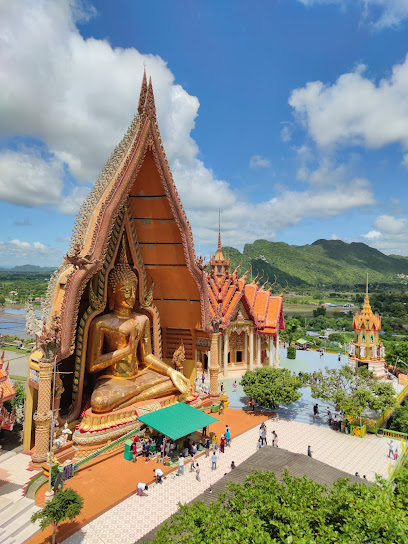
Erawan National Park
Discover the breathtaking beauty of Erawan National Park, where stunning waterfalls and lush jungles await every adventurer.

Giant Raintree (Monkey Pod Tree)
Discover the breathtaking Giant Raintree in Kanchanaburi, a stunning natural attraction perfect for nature lovers and photographers alike.
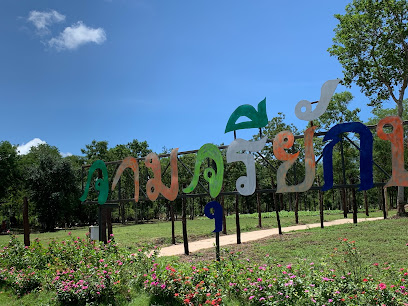
Namtok Sai Yok Noi (Namtok Khao Pang)
Experience the serene beauty of Namtok Sai Yok Noi, a captivating waterfall in Kanchanaburi, ideal for nature lovers and adventure seekers.

River Khwae Bridge
Explore the River Khwae Bridge, an iconic landmark in Kanchanaburi that embodies history, beauty, and resilience, making it a must-see for every traveler.

Mallika R.E 124
Experience the vibrant culture of Kanchanaburi at Mallika R.E 124, where tradition, art, and authentic Thai cuisine come together.

Hellfire Pass Interpretive Centre
Explore the depths of history at Hellfire Pass Interpretive Centre, a poignant museum dedicated to the legacy of the Death Railway in Thailand.

JJ Night Market Kanchanaburi
Discover the flavors and crafts of Kanchanaburi at JJ Night Market, a vibrant evening destination filled with food, culture, and entertainment.

Wat Tham Phu Wa
Explore the serene Wat Tham Phu Wa, a captivating Buddhist temple in Kanchanaburi, Thailand, known for its stunning caves and tranquil atmosphere.

Kroeng Krawia Waterfall
Experience the natural beauty and tranquility of Kroeng Krawia Waterfall, a serene retreat in Kanchanaburi, Thailand.

Mueang Sing Historical Park
Explore the enchanting Mueang Sing Historical Park, a treasure trove of Khmer architecture set amidst the stunning landscapes of Kanchanaburi.

Sai Yok National Park
Explore the breathtaking landscapes and rich wildlife of Sai Yok National Park, a serene retreat in the heart of Thailand's natural beauty.

Wat Ban Tham
Experience the tranquility and beauty of Wat Ban Tham, a stunning Buddhist temple in Kanchanaburi that offers breathtaking views and spiritual reflection.

Erawan Falls
Discover the enchanting Erawan Falls in Kanchanaburi, a stunning seven-tiered waterfall surrounded by lush nature, perfect for adventure and relaxation.

Skywalk Kanchanaburi City
Discover breathtaking views and serene walks at Skywalk Kanchanaburi City, the ultimate destination for nature lovers and adventurers alike.

Unmissable attractions to see
Wat Tham Suea
Experience the serenity and beauty of Wat Tham Suea, a breathtaking Buddhist temple in Kanchanaburi, Thailand, offering spiritual insights and stunning views.

Erawan National Park
Explore the breathtaking beauty and diverse wildlife of Erawan National Park, a must-visit national park in Kanchanaburi, Thailand.
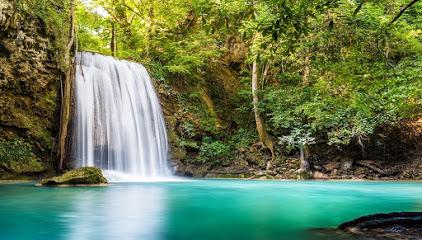
Giant Raintree (Monkey Pod Tree)
Discover the enchanting Giant Raintree in Kanchanaburi, a breathtaking natural attraction perfect for relaxation and photography amidst Thailand's stunning landscapes.
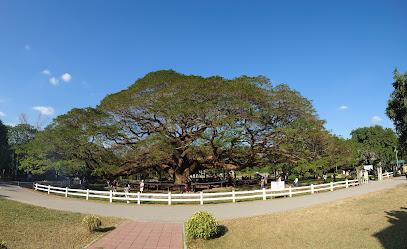
Sai Yok Noi Waterfall (Khao Pang Waterfall)
Experience the natural beauty of Sai Yok Noi Waterfall in Kanchanaburi, a serene and picturesque attraction perfect for relaxation and adventure.
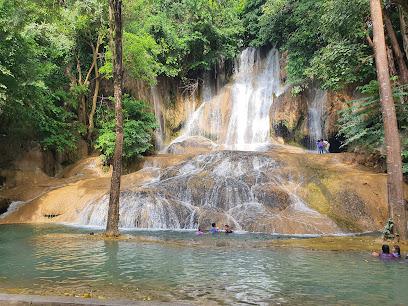
River Khwae Bridge
Discover the River Khwae Bridge, a historic landmark in Kanchanaburi, Thailand, blending poignant history with stunning natural beauty.

Wat Tham Phu Wa
Explore the mystical Wat Tham Phu Wa, a serene Buddhist temple in Kanchanaburi, Thailand, adorned with stunning cave formations and rich spiritual heritage.

Mueang Sing Historical Park
Explore the ancient ruins of Mueang Sing Historical Park in Kanchanaburi, a mesmerizing site of historical significance and natural beauty.

Wat Ban Tham
Discover serene spirituality at Wat Ban Tham, a stunning Buddhist temple nestled in Kanchanaburi's lush landscapes and unique cave formations.

Skywalk Kanchanaburi City
Experience breathtaking views at Kanchanaburi's Skywalk, an architectural marvel blending nature and adventure for an unforgettable visit.

Wat Tham Khiritham
Discover the serene beauty of Wat Tham Khiritham, a stunning Buddhist temple in Kanchanaburi, Thailand, perfect for meditation and reflection.

Thailand-Burma Railway Centre
Explore the poignant history of the Thailand-Burma Railway at this insightful museum in Kanchanaburi, a tribute to resilience during World War II.
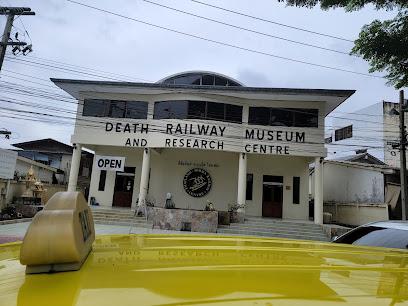
Wat Thewa Sangkharam
Experience the serene beauty and cultural richness of Wat Thewa Sangkharam, a must-visit Buddhist temple in Kanchanaburi, Thailand.

Elephants World
Experience the beauty of nature and the gentle giants of Elephants World, a sanctuary dedicated to the care and rehabilitation of elephants in Kanchanaburi.

Had Sai Nam Jued Tha Lo
Experience the tranquility and natural beauty of Had Sai Nam Jued Tha Lo, a hidden gem in Kanchanaburi perfect for relaxation and cultural immersion.

SUP Hire (Thailand) Co., Ltd ซับบอร์ดกาญจนบุรี
Experience stand-up paddleboarding in the breathtaking landscapes of Kanchanaburi, where adventure meets nature's beauty.

Essential places to dine
Keeree Mantra Kanchanaburi
Savor authentic Thai cuisine with stunning riverside views at Keeree Mantra Kanchanaburi - a must-visit destination for food lovers.

Keeree Tara
Experience authentic Thai flavors at Keeree Tara while enjoying breathtaking views of the River Kwai in Kanchanaburi.

ครัวชุกโดน
Discover the rich flavors of authentic Thai cuisine at ครัวชุกโดน in Kanchanaburi – a culinary gem offering delightful dishes and meal delivery.

On’s Thai-Issan Vegan
Discover the flavors of Thailand at On’s Thai-Issan Vegan - where plant-based meets authentic culinary art in Kanchanaburi.

Taraburee (ธาราบุรี)
Discover authentic Thai cuisine at Taraburee in Kanchanaburi – a must-visit restaurant for all food enthusiasts.

Zab Zab แซบ แซบ
Experience the vibrant flavors of Thailand at Zab Zab แซบ แซบ in Kanchanaburi – where every dish tells a story.

Soon Heng Restaurant
Discover authentic Thai flavors at Soon Heng Restaurant in Kanchanaburi - where every dish tells a story.

Lakeview Cafe and Restaurant
Discover exquisite Thai flavors amidst stunning lakeside views at Lakeview Cafe and Restaurant in Kanchanaburi.

Thaiseree Restaurant
Experience authentic Thai flavors at Thaiseree Restaurant in Kanchanaburi—where every meal tells a story.

@Chanchala (ร้านอาหาร แอทชานชาลา)
Experience authentic Thai flavors at @Chanchala in Kanchanaburi – where every meal tells a story.

Bell's Pizzeria
Experience the best pizza in Kanchanaburi at Bell's Pizzeria – where authentic flavors meet local charm.

Schluck Restaurant Kanchanaburi
Savor authentic European cuisine at Schluck Restaurant in Kanchanaburi – where every dish tells a story.

Kin Khao Lam Restaurant
Experience authentic Thai flavors at Kin Khao Lam Restaurant in Kanchanaburi - where every dish tells a story.

Suan Bua
Experience authentic Thai flavors at Suan Bua in Kanchanaburi—a must-visit for culinary enthusiasts seeking genuine local cuisine.

EatSmith
Discover authentic Thai cuisine at EatSmith in Kanchanaburi - where tradition meets taste in every delightful dish.

Markets, malls and hidden boutiques
Robinson Lifestyle Kanchanaburi
Discover the vibrant shopping and dining experience at Robinson Lifestyle Kanchanaburi, where modern convenience meets local culture.

ร้านข.ไข่เครื่องเขียน
Discover your creative side at ร้านข.ไข่เครื่องเขียน, Kanchanaburi's charming stationery haven filled with unique writing supplies and gifts.

ศูนย์จำหน่ายเครื่องสำอาง เคโอไดเร็คเซลล์
Explore K.O. Direct Sell Cosmetics Store in Kanchanaburi for a delightful beauty shopping experience, offering a wide range of high-quality products.

ห้างหุ้นส่วนจำกัด อักษรภัณฑ์กาญจนบุรี
Discover Kanchanaburi's finest stationery store, where creativity meets culture in every unique product.

กาญจน์ดนตรีนาฬิกาและกีฬา
Explore a unique blend of musical instruments, clock repair services, and sporting goods in Kanchanaburi's cultural hub.

ร้านกิ๊บเก๋ส์
Explore the vibrant gift shop scene in Kanchanaburi at ร้านกิ๊บเก๋ส์, where unique Thai souvenirs meet local craftsmanship.

วัตสันกนกเพชร กาญจนบุรี : WATSONS KANOKPETCH KANCHANABURI : Click & Collect
Experience the best in health and beauty at Watsons Kanokpetch Kanchanaburi - a treasure trove of skincare, cosmetics, and pharmacy essentials.

Cute Press กาญจนบุรี
Explore Cute Press in Kanchanaburi for a delightful cosmetics shopping experience, featuring quality products and expert advice in a charming atmosphere.

ร้าน ดาวกีฬา
Discover ร้าน ดาวกีฬา in Kanchanaburi: Your one-stop shop for all sporting goods and local adventure gear.

Thailand Sporting Goods Shop
Explore Kanchanaburi's top destination for sporting goods, offering quality clothing and uniforms for all your outdoor adventures.

AK Jewelry Design
Explore exquisite handcrafted jewelry at AK Jewelry Design in Kanchanaburi, a perfect blend of Thai artistry and modern elegance.

ร้าน เหลียงพานิช ตลาดผาสุก
Explore the enchanting world of toys at ร้าน เหลียงพานิช in Kanchanaburi, a perfect stop for families and collectors alike.
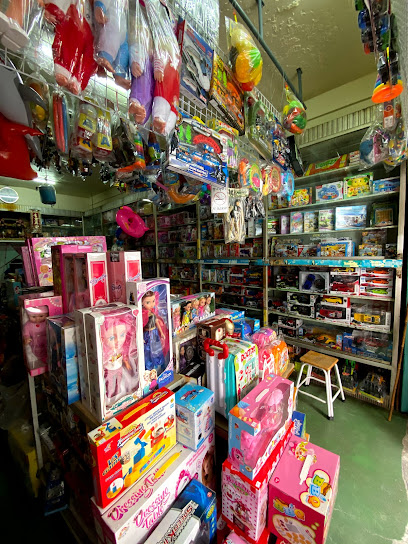
Kwan & ooy shop
Explore the beauty of Kanchanaburi at Kwan & Ooy Shop, your go-to cosmetics store for authentic Thai beauty products and exceptional service.

ร้านตุ๋ย ตลาดผาสุก กาญจนบุรี
Shop at ร้านตุ๋ย in Kanchanaburi for trendy clothing that combines local flair with modern styles, perfect for all ages and body types.

ร้านจุดเปลี่ยน โกโก้ ลาวา หนึบ
Experience the rich flavors of lava chocolate drinks at ร้านจุดเปลี่ยน โกโก้ ลาวา หนึบ, a cozy coffee shop in beautiful Kanchanaburi.

Essential bars & hidden hideouts
Aussie Rules Bar
Experience the lively atmosphere of Aussie Rules Bar in Kanchanaburi, where Australian culture meets Thai hospitality amidst stunning landscapes.

Easy Bar
Experience the lively ambiance and delightful drinks at Easy Bar, Kanchanaburi's must-visit spot along the scenic River Kwai.

Motown Bar Kanchanaburi
Discover the lively Motown Bar in Kanchanaburi, where vibrant nightlife meets friendly faces and unforgettable experiences.

IRIE Bar Kanchanaburi
Experience the vibrant nightlife of Kanchanaburi at Irie Bar, where refreshing drinks meet a lively atmosphere in a charming setting.

The Tavern Bar
Discover the vibrant atmosphere of The Tavern Bar in Kanchanaburi, where great drinks and local culture come together for an unforgettable experience.

Tamnan Bar Beer
Experience the vibrant nightlife of Kanchanaburi at Tamnan Bar Beer, where local drinks and friendly vibes await.

Sugar Member
Experience the vibrant nightlife at Sugar Member, a top bar in Kanchanaburi with great drinks, pool, and a lively atmosphere by the River Kwai.
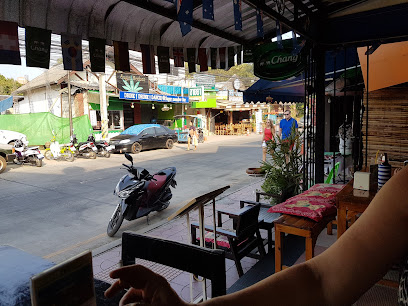
Vibe Kanchanaburi
Experience the vibrant atmosphere and exquisite cocktails at Vibe Kanchanaburi, the perfect riverside retreat for tourists seeking relaxation and enjoyment.

Betty Boop Bar
Experience the vibrant nightlife at Betty Boop Bar, a must-visit bar along the scenic River Kwai in Kanchanaburi, Thailand.
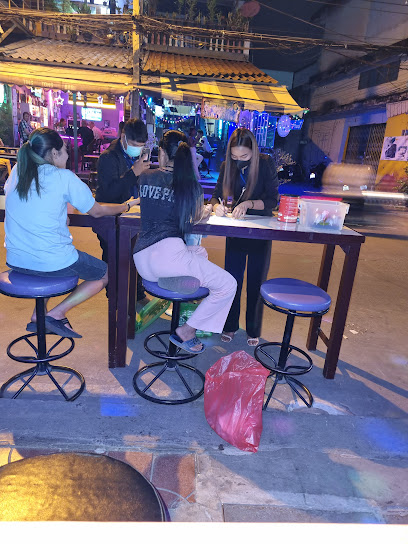
Su Bar
Experience the vibrant nightlife of Kanchanaburi at Su Bar, where friendly service meets an impressive drink selection along the scenic River Kwai.

บาร์ลับ กาญจนบุรี
Experience the vibrant nightlife of Kanchanaburi at Bar Rub, where creative cocktails meet a lively atmosphere in a hidden gem of a bar.

Noot's Bar and Homestay
Experience the serene beauty of the River Kwai at Noot's Bar and Homestay, where relaxation meets local culture in Kanchanaburi.

Salmon Bar
Discover the lively Salmon Bar along the River Kwai, where exquisite drinks meet stunning views in a vibrant atmosphere.

The ZEED 2020
Experience the vibrant nightlife at The ZEED 2020, a lively bar in Kanchanaburi known for its refreshing drinks and welcoming atmosphere.
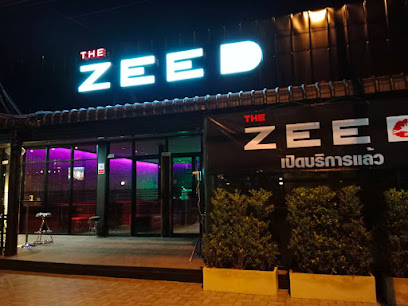
Cuddle Bar
Discover the lively Cuddle Bar in Kanchanaburi, where vibrant nightlife meets friendly service and great drinks, making it a must-visit for tourists.

Local Phrases
-
- Helloสวัสดี
[sawasdee] - Goodbyeลาก่อน
[laa kon] - Yesใช่
[chai] - Noไม่
[mai] - Please/You're welcomeโปรด/ยินดี
[proht/yindee] - Thank youขอบคุณ
[khop khun] - Excuse me/Sorryขอโทษ
[kho thot] - How are you?สบายดีไหม
[sabai dee mai] - Fine. And you?สบายดีค่ะ/ครับ คุณล่ะ
[sabai dee ka/khrap kun la] - Do you speak English?คุณพูดภาษาอังกฤษได้ไหม
[kun put phasa angkrit dai mai] - I don't understandฉันไม่เข้าใจ
[chan mai khao jai]
- Helloสวัสดี
-
- I'd like to see the menu, pleaseขอดูเมนูหน่อย
[kho duu menu noi] - I don't eat meatฉันไม่กินเนื้อ
[chan mai kin neuua] - Cheers!ชนเหยาะ
[chon yao] - I would like to pay, pleaseขอจ่ายเงินหน่อย
[kho jai ngeun noi]
- I'd like to see the menu, pleaseขอดูเมนูหน่อย
-
- Help!ช่วยด้วย
[chuai duay] - Go away!ไปไกลๆ
[bpai glai glai] - Call the Police!โทรตำรวจ
[thor tamruat] - Call a doctor!โทรหมอ
[thor mor] - I'm lostฉันหลงทาง
[chan long tang] - I'm illฉันไม่สบาย
[chan mai sabai]
- Help!ช่วยด้วย
-
- I'd like to buy...ฉันต้องการซื้อ...
[chan tong kaan seuu...] - I'm just lookingฉันแค่ดูด้วย
[chan khae duu duay] - How much is it?ราคาเท่าไหร่
[raa kha thao rai] - That's too expensiveแพงเกินไป
[paeng gein pai] - Can you lower the price?ลดราคาได้ไหม
[lot raa kha dai mai]
- I'd like to buy...ฉันต้องการซื้อ...
-
- What time is it?ขณะนี้กี่โมง
[khan nee kee mong] - It's one o'clockตอนนี้เป็นโมงเดียว
[dton nee bpen mong diao] - Half past (10)ห่างโมง (10)
[hang mong (sip)] - Morningเช้า
[chao] - Afternoonบ่าย
[bai] - Eveningเย็น
[yen] - Yesterdayเมื่อวาน
[meua waan] - Todayวันนี้
[wan nee] - Tomorrowพรุ่งนี้
[phung nee] - 1หนึ่ง
[neung] - 2สอง
[song] - 3สาม
[sam] - 4สี่
[si] - 5ห้า
[ha] - 6หก
[hok] - 7เจ็ด
[jet] - 8แปด
[paet] - 9เก้า
[gao] - 10สิบ
[sip]
- What time is it?ขณะนี้กี่โมง
-
- Where's a/the...?...อยู่ที่ไหน
[... yu tee nai] - What's the address?ที่อยู่อยู่ที่ไหน
[tee yu yu tee nai] - Can you show me (on the map)?ช่วยแสดงให้ฉันดู (บนแผนที่)
[chuai sa-dang hai chan duu (bon paen tee)] - When's the next (bus)?รถเมลล์ตอนหน้าเมลล์เวลาไหน
[rodt mel ton naa mel wela nai] - A ticket (to ....)ตั๋ว (ไป...)
[dtua (bpai...)]
- Where's a/the...?...อยู่ที่ไหน
History of Kanchanaburi
-
Kanchanaburi's history dates back to prehistoric times, with archaeological evidence indicating that the area was inhabited by early humans. The fertile land along the River Kwai provided an ideal setting for early agricultural communities. Over time, these settlements evolved into more complex societies, laying the foundation for Kanchanaburi's rich cultural tapestry.
-
During the Ayutthaya Kingdom (1351-1767), Kanchanaburi served as a strategic outpost to protect the kingdom from Burmese invasions. The city was fortified and played a crucial role in military campaigns. The remnants of old city walls and fortifications still stand as a testament to this era's historical significance.
-
Kanchanaburi was a significant battleground during the Burmese-Siamese conflicts. The area witnessed several fierce battles, especially during the late 18th century when the Burmese sacked Ayutthaya. Many historical sites and monuments in Kanchanaburi, including the Don Chedi Memorial, commemorate this turbulent period.
-
One of the most poignant chapters in Kanchanaburi's history is its role during World War II. The Japanese Imperial Army used Allied prisoners of war and Asian laborers to construct the Thailand-Burma Railway, infamously known as the Death Railway. The Bridge over the River Kwai stands as a somber reminder of the thousands who perished during its construction. The Hellfire Pass Memorial and the Kanchanaburi War Cemetery further honor the memory of those who suffered.
-
Following the end of World War II, Kanchanaburi underwent significant reconstruction and modernization. The city transformed from a war-torn area into a thriving tourist destination. Efforts to preserve its historical sites and natural beauty have made Kanchanaburi a key location for cultural and historical tourism in Thailand.
-
Kanchanaburi is home to a rich cultural heritage, reflected in its numerous festivals and traditions. The River Kwai Bridge Festival, held annually in late November to early December, features a sound and light show that recounts the history of the Death Railway. The city also celebrates traditional Thai festivals such as Songkran (Thai New Year) and Loy Krathong with great enthusiasm, showcasing the vibrant culture of the region.
Kanchanaburi Essentials
-
Kanchanaburi is accessible from Bangkok, the capital of Thailand. The most convenient way to get there is by train from Bangkok's Thonburi Station, which offers scenic views along the journey. The trip usually takes around 2.5 to 3 hours. Alternatively, you can take a bus from Bangkok's Southern Bus Terminal (Sai Tai Mai), which offers frequent departures. The drive typically takes around 2 to 3 hours, depending on traffic. For a more personalized experience, private taxis or car rentals are also available.
-
Once in Kanchanaburi, getting around is relatively straightforward. Songthaews (shared taxis) and tuk-tuks are widely available and can be hailed on the street. Motorbike rentals are another popular option for exploring the town and its surrounding attractions. For longer distances, buses and minivans can take you to nearby towns and tourist spots. If you prefer a more comfortable option, private taxis can be hired for trips within and outside the city.
-
The official currency in Thailand is the Thai Baht (THB). Credit and debit cards are widely accepted in hotels, restaurants, and larger shops in Kanchanaburi. However, it is advisable to carry some cash for smaller purchases and transactions in local markets. ATMs are readily available throughout the town, and currency exchange services can be found in banks and authorized exchange booths.
-
Kanchanaburi is generally a safe destination for tourists. However, it is always important to stay vigilant. Avoid walking alone at night in poorly lit areas, and keep an eye on your belongings in crowded places. Petty theft and scams targeting tourists can occur, so be cautious when dealing with strangers. It is recommended to use reputable transportation services and avoid unlicensed taxis. Areas around the bus and train stations can occasionally have higher instances of petty crime, so be extra cautious in these areas.
-
In case of an emergency, dial 191 for police assistance and 1669 for medical emergencies. Kanchanaburi has several hospitals and medical clinics that can provide emergency medical care. It is advisable to have travel insurance that covers medical expenses. For minor health issues, pharmacies are available throughout the town where you can purchase over-the-counter medications. The nearest police station and medical facilities can be found in the town center.
-
Fashion: Do dress modestly, especially when visiting religious sites. Avoid wearing revealing clothing. Religion: Do respect local customs and traditions. Always remove your shoes when entering temples and dress appropriately. Public Transport: Do be respectful and give up your seat to elderly passengers. Don’t eat or drink on public transport. Greetings: Do greet people with a wai, a slight bow with hands pressed together. Eating & Drinking: Do try local delicacies and accept food offerings graciously. Don’t refuse hospitality, as it is considered impolite.
-
To experience Kanchanaburi like a local, visit the local markets such as the Kanchanaburi Night Market, where you can buy fresh produce and traditional Thai goods. Engage with locals, as they are often friendly and willing to share stories about the town's history and culture. Don't miss visiting the Erawan National Park and its stunning waterfalls. For a unique experience, take a ride on the Death Railway, which offers a poignant reminder of World War II history and breathtaking views of the surrounding landscape.
Trending Landmark in Kanchanaburi
-
Wat Tham Suea (Tiger Cave Temple)
-
Erawan National Park
-
Giant Raintree (Monkey Pod Tree)
-
Namtok Sai Yok Noi (Namtok Khao Pang)
-
River Khwae Bridge
-
Mallika R.E 124
-
Hellfire Pass Interpretive Centre
-
JJ Night Market Kanchanaburi
-
Wat Tham Phu Wa
-
Kroeng Krawia Waterfall
-
Mueang Sing Historical Park
-
Sai Yok National Park
-
Wat Ban Tham
-
Erawan Falls
-
Skywalk Kanchanaburi City
Nearby Cities to Kanchanaburi
-
Things To Do in Bangkok
-
Things To Do in Ayutthaya
-
Things To Do in Samut Prakan
-
Things To Do in Hua Hin
-
Things To Do in Pattaya
-
Things To Do in Rayong
-
Things To Do in Nakhon Ratchasima
-
Things To Do in Sukhothai
-
Things To Do in Hpa-An
-
Things To Do in Trat
-
Things To Do in Chumphon
-
Things To Do in Battambang
-
Things To Do in Loei
-
Things To Do in Kyaiktiyo
-
Things To Do in Ranong















